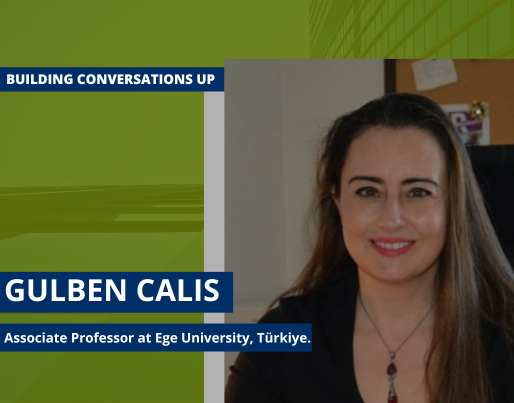Gulben Calis: ‘There is still an undiscovered potential for utilising machine learning methods for assessing and predicting the thermal comfort of buildings’ occupants’

Gulben Calis: ‘There is still an undiscovered potential for utilising machine learning methods for assessing and predicting the thermal comfort of buildings’ occupants’
Introduction
Dr. Gülben Calis is an Associate Professor and Head of Construction Management Division at the Department of Civil Engineering of Ege University, Türkiye. She was awarded the post-doctoral research fellowship by TÜBİTAK and worked as a post-doctoral researcher at the University of Southern California. During the last 15 years, her research focused on the acquisition, modelling, and analysis of the data needed for user-centred built/outdoor environments and the development of novel frameworks to improve the environments’ efficiency and safety while increasing user satisfaction, productivity, and health. To date, she has published more than 100 peer-reviewed papers, and her work has received support from a variety of national and international sources, including the European Commission. She is one of the founding members of the Human-Data Interaction Committee of the European Council on Computing in Construction (EC3) and is an ambassador of BUILD-UP. She serves as a reviewer to well-respected journals such as Energy Reviews and is a member of the Editorial Review Board of the Smart and Sustainable Built Environment journal. She also works as an external expert for the European Commission since 2015.
BUILD UP (BUP): How can thermal comfort be defined? How is it linked to Indoor Environmental Quality (IEQ)?
GULBEN CALIS (GB): Thermal comfort is a subjective measure of how comfortable a person feels with the surrounding thermal conditions, influenced by various factors such as air temperature, relative humidity, air velocity, and personal factors. Thermal comfort is also an important component of IEQ along with indoor air quality, visual comfort and acoustic comfort. Although the importance and weight of IEQ aspects are different due to diverse climates, building types and individual differences, thermal comfort receives certain consideration since it directly affects the well-being and productivity of occupants.
BUP: Are there specific standards on thermal comfort and Indoor Air Quality (IAQ)?
GC: The two most frequently used standards for thermal comfort are ISO Standard 7730 and American Society of Heating, Air Conditioning & Refrigeration Engineers, US (ASHRAE) Standard 55. European Standard EN 12464-1 specifies lighting requirements for indoor workplaces and their associated areas in terms of quantity and quality of illumination. Regarding IAQ standards, they are mostly implicit, based off guidelines created by governmental agencies, health organisations, and expert committees to safeguard the health, comfort, and well-being of occupants by ensuring that the indoor air has acceptable levels of pollutants and conditions. Thus, while there is no definitive list of standards kept on record, the ambient air quality standards set by ASHRAE are designed for indoor environments, especially where building HVAC systems are used, the WHO air quality standards are designed for the general environment and those set by OSHA, NIOSH, and ACGIH are used for industrial environments. The EU laws set pollutant concentration thresholds that shall not be exceeded in a given period of time. It’s important to note that IAQ standards can vary from country to country due to differences in environmental conditions, building practices, and health concerns. It is notable that recent recommendations by local and international regulatory bodies include the use of a smart IAQ monitor in private and public buildings to ensure healthier environments.
'IAQ standards can vary from country to country due to differences in environmental conditions, building practices, and health concerns'
BUP: What are the means and methods to assess the thermal comfort of buildings´ occupants?
GC: Both ASHRAE 55 and ISO 7730 standards are based on Fanger’s model in which the Predicted Mean Vote (PMV) and Predicted Percentage of Dissatisfied (PPD) indices are used for assessing and predicting occupant thermal comfort in indoor environments. However, numerous studies have already identified gaps between the actual thermal comfort of occupants and the PMV, which tends to underestimate thermal discomfort in hot and humid climates and overestimate it in cold and dry climates. The second main traditional thermal comfort prediction model is the adaptive model, which provides thermal comfort prediction of occupants while considering the thermal preferences of building occupants and the adjustments made by occupants to maintain their comfort requirements. Although adaptive thermal comfort models are becoming more widely recognised and accepted in building regulations, their implementation constitutes some limitations and challenges, including the need for greater consistency, standardisation, and more data on adaptive behaviour in different cultures. To address these drawbacks, recently machine learning-based thermal comfort models have been proposed to obtain more accurate estimations of thermal comfort that can be adapted in real-time, can process complex data, and can be integrated into smart building systems. I believe that there is still an undiscovered potential for utilising machine learning methods for assessing and predicting the thermal comfort of buildings’ occupants.
BUP: Can you present some projects focusing on IAQ and thermal comfort, both in residential and non-residential buildings?
GC: Although indoor air quality and thermal comfort have always been an interesting area for research, they often remained as criteria that had to be met along with challenges such as improving the energy efficiency of buildings. Recently, there has been a substantial increase in the number of projects that mainly focus on these two subjects. The EU-funded projects such as InChildHealth and LEARN focus particularly on improving IAQ in schools whereas the INQUIRE project tackles IAQ in residential buildings. Projects such as TwinAIR and K-HEALTHinAIR aim at addressing IAQ challenges both in non-residential and residential buildings. Research activities in these projects either focus on the complex relationship between IAQ and external factors and their effects on occupant health or the development of tools and sensors to improve IAQ.
BUP: Do you think the COVID-19 pandemic has helped in increasing awareness among people, governments, and companies on the importance of IAQ for our wellbeing?
GC: IAQ has always been a crucial aspect of indoor health and comfort. However, COVID-19 has helped us to gain new insights with respect to the role of people, governments and companies in maintaining and ensuring IAQ. First, the pandemic received extensive media coverage, including discussions about the importance of IAQ in preventing the spread of COVID-19. This coverage reached a wide audience and contributed to public awareness. Secondly, many governments, regulatory bodies as well as health organisations including WHO introduced or updated guidelines and regulations related to IAQ, requiring us to change our usual practices in buildings. These changes also led to an acceleration in the development and adoption of IAQ technologies such as advanced purification systems and real-time monitoring devices, making it easier for individuals and organisations to assess and improve IAQ. Overall, the pandemic has not only significantly increased awareness but also encouraged a broader and longer-term perspective on IAQ beyond COVID-19. Many now view IAQ as a key aspect of building design and operation that can have a lasting impact on occupant health and well-being.
'The pandemic has not only significantly increased awareness but also encouraged a broader and longer-term perspective on IAQ beyond COVID-19'
BUP: How is Türkiye engaging with IAQ and thermal comfort in buildings? Are you ahead on these topics or do you think there is still a long way to improve in terms of research and implementation?
GC: In Türkiye, various legal regulations and standards are in place regarding IAQ and thermal comfort. Among these, the Turkish Standards Institution has prepared a series of Turkish Standards that aim at improving IAQ and thermal comfort in buildings. Additionally, the Ministry of Environment and Urbanisation has published guidelines for control strategies to ensure IAQ. Furthermore, there are regulations for building energy performance and green building certification, which are indirectly related to IAQ and thermal comfort. The former aims to reduce energy consumption in buildings whilst improving indoor air quality, while the latter certifies that buildings adhere to environmentally friendly design and operational principles. Regarding research and education, interest in IAQ in Türkiye has been expanding, and the number of studies on IAQ and thermal comfort has been increasing. Universities, research institutions, and civil society organisations organise educational programs to raise awareness. The biennial Indoor Air Quality Symposium initiated in 2007, is of great importance in showcasing the country's progress in the field of science. From a technological standpoint, leading investors in the country's HVAC sector have established Europe's first HVAC experience centre and are introducing innovative air purification technologies to the country. In general, Türkiye has taken significant steps in these areas, both at the governmental and the private sector levels. Nonetheless, there is a persistent need for ongoing improvement and development in this field, with a particular emphasis on considering the well-being of occupants and designing spaces with a human-centric approach.


